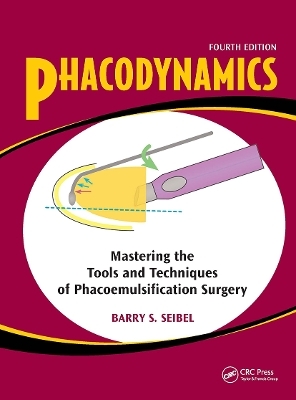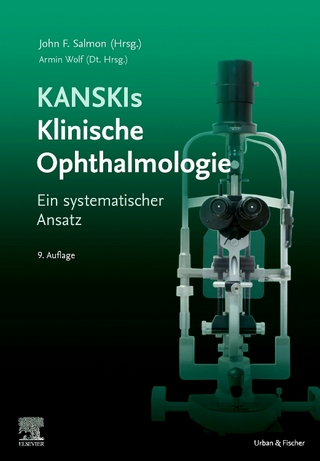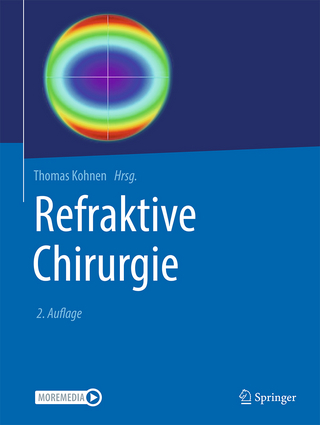
Phacodynamics
SLACK Incorporated (Verlag)
978-1-55642-688-9 (ISBN)
The revised, expanded, and updated Fourth Edition of this classic text includes over 300 simple, yet elegant, figures and illustrations detailing the latest machine technologies and surgical techniques. Visual learners…
In addition to examining the intricate relationship between the surgeon and the phaco machine, Dr. Barry Seibel profiles how the most recent advancements in machine technology can enhance your surgical procedures and optimize your results. With schematic figures and illustrations to accompany the detailed descriptions, surgeons can readily identify and distinguish between various flow pumps, vacuum pumps, and ultrasound power modulations. Surgery can then be customized moment by moment for each individual patient to maximize safety and efficacy.
Phacodynamics, Fourth Edition utilizes a simplified approach to explain all the latest advancements in phaco technology and surgery and should be in the hands of all surgeons practicing in this specialized area.
New topics included that are unique to this Fourth Edition:
Bimanual Microincision Phaco Ultrasound Power Modulations including Burst and Pulse Modes AquaLase and Laser Surgical Technologies Expanded Horizontal Chopping Techniques including PreChop Vertical Chopping Techniques and Instrumentation Bimanual Irrigation and Aspiration Phacodynamic Complications Phacodynamics of Surgical Instrument Design
Barry S. Seibel, MD. Clinical Assistant Professor of Ophthalmology, University of California, Los Angeles School of Medicine.
Contents Dedication Acknowledgments Preface to the Fourth Edition Preface to the Third Edition Preface to the Second Edition Preface to the First Edition xiv Foreword to the Fourth Edition Foreword to the Third Edition Section I: Machine Technology Machine Overview Bimanual Microincision Phaco: Alternate Irrigation Path Foot Pedal Irrigating Bottle Flow Pumps Flow Pumps: Overview and Peristaltic Pump Scroll Pump Flow Pumps: Direct Control of Flow and Indirect Control of Vacuum Flow Pumps: Tip Occlusion Effects on Flow and Vacuum Flow Pumps: Direct Vacuum Control with Tip Occlusion Rise Time: Flow Pumps Rise Time: Flow Pump Compliance Rise Time: Flow Pump Venting and Vacuum Limit Preset Schematic Machine: Flow Pump Relationship Among Flow Rate, Rise Time, and Vacuum Relationship Between Flow and Vacuum 1 Relationship Between Flow and Vacuum 2 Vacuum Pumps Vacuum Pumps: Overview and Venturi Diaphragm Pump Rotary Vane Pump Vacuum Pumps: Direct Control of Vacuum and Indirect Control of Flow Vacuum and Flow Pumps: Flow Resistance Vacuum Pumps: Control of Flow and Grip; Vacuum Transfer Upon Tip Occlusion Vacuum Pumps: Direct Control of Vacuum and Grip Vacuum Pump Emulation by Flow Pumps Control Strategy: Flow Pump vs Vacuum Pump Rise Time: Vacuum Pumps Vacuum Pumps: Relationship Between Rise Time and Vacuum Vacuum Pumps: Pedal Control of Rise Time Clinical Fluidics Fluidic Resistors Affecting Flow: Vacuum Pump Fluidic Resistors Affecting Flow: Vacuum Pump vs Flow Pump Fluidic Resistors Affecting Vacuum: Flow Pump Vacuum Degradation in Aspiration Line Bottle Height: Relationship to Flow Baseline Resistance to Flow Flow Control: Vacuum vs Flow Pumps Compliance and Air Venting Compliance and Fluid Venting Surge External Surge Suppression Ultrasound Ultrasound Overview Sculpt vs Occlude Ultrasound: Gel vs Solid Ultrasound Power Modulations: Linear Continuous Ultrasound Power Modulations: Fixed Panel Continuous Ultrasound Power Modulation: Pulse Mode Ultrasound Power Modulation: Burst Mode Ultrasound Power Modulation: HyperPulse Ultrasound Power Modulations: Decreased Ultrasound Time Pulse and Burst Modes Contraindication with Sculpting Phaco Needle Tip Angles: Occludability 1 Phaco Needle Tip Angles: Occludability 2 Tip Angles and Aspiration Port Surface Area Phaco Needle Dimensions Ultrasonic Cavitation and Needle Design Thermal Implications of Ultrasound: Needle Designs Alternate Modalities of Phacoemulsification: Ultrasound Variations Alternate Modalities to Ultrasound: Laser AquaLase and Laser Surgical Techniques Irrigation and Aspiration Tips Individual Machine Characteristics Section II: Logic of Setting Machine Parameters Overview of Logic Behind Setting Machine Parameters Anterior Chamber Currents Flow Rates and Currents Force and Currents Flow and Vacuum Settings 1: Distal Followability Flow and Vacuum Settings 2: Proximal Followability Flow and Vacuum Settings 3: Grip Control Inputs and Aspiration Port Occlusion: Flow Pumps vs Vacuum Pumps Parameter Modulation with Hardware Modification Sculpting Settings: Vacuum, Flow, and Bottle Height Sculpting Settings: Ultrasound Linear Phaco Sculpting Quadrant Settings 1 Quadrant Settings 2 Settings for Quadrant/Fragment Emulsification: Balancing Fluidics and Ultrasound Phaco Chop Settings: Horizontal Chop Modified Horizontal Chop: Stop and Chop 1 Modified Horizontal Chop: Dynamic Linear Parameter Adjustment Vertical Chop Settings 1 Vertical Chop Settings 2 Epinucleus Settings 1 Epinucleus Settings 2 Cortical Removal Settings Viscoelastic Removal Settings Section III: Overview of Phacoemulsifcation Techniques Viscoelastic Removal Settings Overview of Phaco Methods Sculpting Angle of Attack Minimum Groove Width Posterior Groove Judging Groove Depth Peripheral Groove Physical Obstructions to Sculpting Use Low to Moderate Scope Magnification Tip Manipulations for Sculpting Groove Avoiding Iris During Sculpting Layers of the Lens Hydrodissection Fluid Dynamics Nuclear Rotation: Torque Principles Nuclear Rotation: Clinical Application of Torque Rotating Nucleus: Pulling with Phaco Tip Rotating Nucleus: Effects of Friction Optimal Instrument Placement for Nuclear Manipulation Nuclear Segmentation 1 Nuclear Segmentation 2 Nuclear Segmentation 3 Nuclear Segmentation 4 Fault-Line Phaco Horizontal Chopping Techniques 1 Horizontal Chopping Techniques 2 Horizontal Chopping Techniques 3: Seibel Chopper Horizontal Chopping Techniques 4: Flat-Head Phaco Tip Vertical Chopping Techniques Chopper Instrumentation Akahoshi Prechop Vacuum Seal Vacuum Seal: Needle Bevel Fragment Manipulation 1 Fragment Manipulation 2 Fragment Manipulation 3 Fragment Manipulation 4: Viscodissection One-Handed Strategies 1 One-Handed Strategies 2 Pivot Around Incisions 1 Pivot Around Incisions 2 Section IV: Irrigation and Aspiration Techniques Cortical Classification Cortical Removal: Large Pieces Instead of Small Bites IA Port Turned Posteriorly Capsule Vacuum Manual Cortical Removal 90º and 45º IA Tips Bimanual Irrigation and Aspiration Using the IOL to Help Remove Cortex Epinuclear Mobilization via Cortical Pulley Section V: Physics of Capsulorrhexis Stress and Strain Shear vs Rip Capsulorrhexis with Shearing Capsulorrhexis with Ripping Maintaining Chamber Depth Combining Techniques Capsulorrhexis Initiation 1 Capsulorrhexis Initiation 2 Capsulorrhexis Initiation 3 Capsulorrhexis Initiation 4 Anterior Cortical Opacities Capsulorrhexis Enlargement Section VI: Phacodynamic Complications Complication 1 Complication 2 Complication 3 Complication 4 Complication 5 Complication 6 Appendices Appendix A: Implied Surface Area in Units of mm Hg Appendix B: Aspiration Port Surface Area Derivation Appendix C: Summary of Pressure Terminology Appendix D: Phacodynamic Analysis in Instrument Design Bibliography Index
| Erscheint lt. Verlag | 31.10.2004 |
|---|---|
| Sprache | englisch |
| Maße | 190 x 254 mm |
| Gewicht | 1528 g |
| Themenwelt | Medizin / Pharmazie ► Medizinische Fachgebiete ► Augenheilkunde |
| ISBN-10 | 1-55642-688-7 / 1556426887 |
| ISBN-13 | 978-1-55642-688-9 / 9781556426889 |
| Zustand | Neuware |
| Haben Sie eine Frage zum Produkt? |
aus dem Bereich


